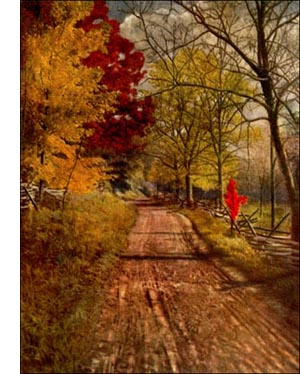Horse Chestnut Tree
 The Horse Chestnut (Aesculus Hippocastanum, Linn.) came originally from southern Asia, and has for centuries been a favourite tree for avenues and parks in Europe. In America it grows with even greater vigour than in the Old World. It is one of the trees commonly planted in the Eastern States, and has escaped from cultivation in many places.
The Horse Chestnut (Aesculus Hippocastanum, Linn.) came originally from southern Asia, and has for centuries been a favourite tree for avenues and parks in Europe. In America it grows with even greater vigour than in the Old World. It is one of the trees commonly planted in the Eastern States, and has escaped from cultivation in many places.Longfellow's "spreading chestnut tree" was a horse chestnut. He called the tree by the name popular in England, where the word "horse" is ordinarily left off. The most aged and imposing specimen trees are to be seen in our Eastern cities, or near them.
The trees reach their best development in more open country away from choking dust and smothering pavements. It is by no means the most desirable of trees, but it improves on acquaintance.
If you are in a city with a bare horse-chestnut tree outside your window, look at it. See the great varnished brown buds that tip the stout twigs. There are small buds on the sides in pairs, but these are evidently subordinates. The twigs are generally forked. This tells that a flower cluster came out of an end bud and the growth of the twig had to be carried up by a pair of side buds. The whole treetop is a great complex system of candelabra-each main branch curves up, then down, then up again to hold all its tips erect.
In late winter a subtle change comes over the horse-chestnut buds. They glimmer with an unwonted light as if warned from within of a great change about to take place. When the warm days come they swell and loosen their waxy scales, showing the silky grey down that lines them, and the close-packed leaves inside. If one would see a miracle he must watch the quick unfolding of the leaf bundle, the lifting of the pale green silvery tent and the spreading of the young leaves into erect umbrellas all over the treetop. During this brief period the trees are enchanting. I wish every house-pent human being could stop work and sit with folded hands and absorb the beauty and inspiration of this spectacle. A brief hour and it is over; the leaflets rise and go about their duties, leaving with us only a memory of their hour of adorable appealing babyhood.
The horse-chestnut tree in bloom is a superb sight- "a pyramid of green supporting a thousand pyramids of white!" Each blossom of the dense cluster has in its throat dashes of red and yellow, and the curving, yellow stamens are thrust far out of the ruffled border of the corolla. If they were rare flowers, they would be admired as orchids are now.
Few of the flowers set seed, as few have perfect pistils. The cluster does quite enough if it matures one or two burs. In fall the small boy assails the trees, knocks off and husks the smooth brown nuts, and how glowing and soft are the colours of them! They are "Conquerors" in games which recur as regularly among town children in the autumn as do games of marbles and the flying of kites in the spring.
The fall of the horse-chestnut leaves is a sudden and absolute surrender. When the time comes, the leaflets and the stem that bore them fall separately. The leaf has evidently expected to come apart, for the joints are perfect: there is no tearing nor breaking involved in the process.
The base of the leaf stalk leaves a scar on the twig which is strikingly like the print of a horse's hoof. This may have given its name to the tree. Or was it, as Gerarde explains, "for that the people of the east countries do with the fruit thereof cure their horses of the cough, shortness of breath, and such like diseases"? More probably the coarse, large, uneatable nuts are responsible; many rank-growing plants unfit for human food are similarly named, e.g., horse mint, horse nettle, horse sugar.
The great fault of the horse chestnut is that it is continually dropping something. "The bud scales first make a considerable litter; then the flowers fall like snow. The unripe fruits drop in all stages, and the leaves that choke to death in the crowded interior turn rusty yellow and drop all summer. It also casts too dense a shade, and in some regions is stripped of its foliage by caterpillars covered with tufts of white hairs-the larvae of the tussock moth. Few people who take thought will choose this tree when elms and hard maples can be had for planting.